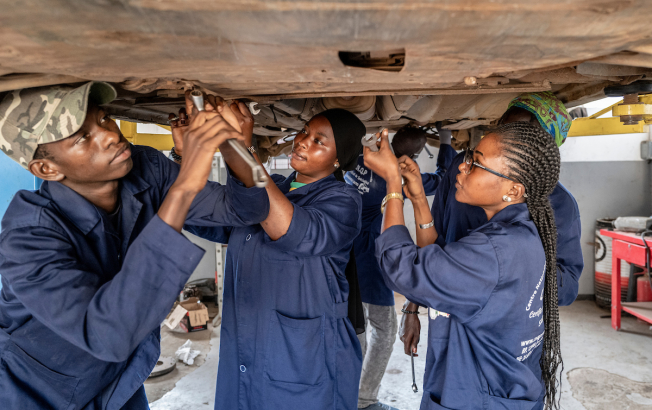Companies operating in Nigeria complain about the quality of skills found in the country’s job market. The concern here is on technical, vocational education and training (TVET). TVET is defined as education, training, and skill development in a variety of occupational fields, production, services, and livelihoods. Adults can benefit from TVET as well as children and youth.
The bosses of these companies have shared first-hand experiences with Edugist about how much they spend in retraining graduates who come applying for various positions with them. A safe conclusion is that Nigeria’s TVET needs an urgent overhaul.
To fix the deteriorating technical and vocational education in Nigeria, certain conditions are necessary. First is a National Qualifications Framework (NQF): this classifies qualifications by level, based on learning outcomes – that is, what the holder of a certificate or diploma is expected to know, understand, and be able to do. When applied to bricklaying for instance, an NQF classifies what an individual with a certain certificate would be able to do, based on learning outcomes. This standardises skill levels.
NQFs aid in the understanding and comparison of qualifications. They can also encourage countries to reconsider and reform national education, training, and lifelong learning policy and practice. At its meeting on Wednesday, April 10, 2013, the Federal Executive Council (FEC) approved a six-level National Skills Qualification Framework (NSQF) for Nigeria.
What has been missing is technical vocation education and training systems, in strong partnership with private sector stakeholders, which must develop, classify, and establish sets of criteria for levels of learning and competency attained in knowledge, application, skills, and the use of technology. A demonstration that private sector participation does improve learning outcomes can be seen in the primary and secondary education sectors.
Since 1999, there has been a steady improvement in primary and secondary education due the private sector participation. This has not been the same for technical and vocational education in Africa’s most populous country, where most TVET schools are government, although this has started changing. But it has equally left technical and vocational education in bad shape. A path to fixing this passes through a private sector-led TVET policy.
Some of the low-hanging fruits of a private-sector-led TVET policy include apprenticeships, internships, and on-the-job learning. The effectiveness of practical learning through apprenticeships, internships, and on-the-job learning has been demonstrated by the German dual system.
Examples from Germany
Both the United Kingdom and German examples have shown the benefits and highlighted the challenges in generating sufficient numbers of apprenticeship and internship placements for young people. Public policies along with business support are essential to promoting and supporting this TVET component.
The German vocational training system, with its combination of classroom and business, theory and practice, learning and working, is recognised worldwide as a fundamental and highly effective model for vocational education. The dual system is well-established in German education, with roots dating back to the Middle Ages. The cooperation between largely private companies on the one hand and public vocational schools on the other is a key feature of the dual system.
This collaboration is governed by law. The term “dual” also refers to a specific constitutional situation in Germany in which the federal government is in charge of vocational training in businesses and the federal states (Länder) are in charge of vocational schools. Thus, the German dual system of vocational training effectively combines theory and practice, knowledge and skills, and learning and working.
There are currently around 350 officially recognised occupational standards in Germany. These standards are an essential component of the German vocational education system. Although they are incorporated into state law, trade and industry also play an important role in their development.
In Germany, more than half of all students who were college-bound in high school but chose not to attend university enrol in vocational training, and many businesses participate in vocational training. Companies provide training voluntarily and frequently at their own expense because they believe it is the best way to meet their own need for skilled workers.
Private companies bear two-thirds of the total annual costs in Germany for (initial) vocational training, which amounts to an average of 15,300 euros per trainee per year. Businesses that participate in the practice believe that training their own new employees is the best method of personnel recruitment.
Training firms save money on recruitment and new-employee training. They also avoid the potential risk of hiring the wrong person for the job. The main advantage for trainees is that they will receive market-relevant training that will improve their chances in the labour market while also improving social skills and developing personalities. Finally, the state benefits from the dual system by reducing the burden on public budgets through enterprise participation and by keeping the workforce up to date.
The German dual system has proven its success over time, and it continues to demonstrate its ability to respond quickly and effectively to the many changes currently affecting the economy and society.
Demographic changes, market globalisation, new technologies, and new work organization models necessitate the development of new educational policy structures in order to meet the demand for a qualified workforce.
As countries with strong internationally competitive economic, scientific, and technological capacities, the United States and Germany have a strong strategic interest in the best qualification concepts.
Both countries design education and training based on the economic and societal demands of lifelong learning, with a focus on competencies and employability, as well as the promotion of transparent and transferable qualifications and the broadening of career paths.
These are models that Nigeria can learn from. It is one thing to have a National Skills Qualification Framework. But how this is adapted to a fast-paced world is a different story. It is also common to hear captains of industry in Nigeria say that the skillsets that they require of recruits are not the ones schools in general and TVET schools, in particular, are teaching.
Now is the time for both government and enterprises to be proactive in dealing with fixing Nigeria’s TVET to create opportunities for the millions of young Nigerians who would not make it to the university and yet have a right to lead a meaningful life.
This is all the more urgent because in the World Economic Forum’s ‘The Future of Jobs and Skills in Africa,’ report four particular areas were earmarked as strategic, which include: ensuring the ‘future-readiness’ of curricula, especially through a focus on Science Technology Engineering and Mathematics (STEM) fields; investing in digital fluency and ICT literacy skills; providing robust and respected technical and vocational education and training (TVET); and creating a culture of lifelong learning, including the provision of adult training and upskilling infrastructure.
Throughout Europe and the world, TVET is rapidly being integrated into tertiary education, particularly through the use of short-cycle programmes linked to two-year certification programmes. Incorporating these wider tracks in higher education offers more flexibility in achieving qualifications and skills. But this must be in collaboration with the private sector.




 elvis@edugist.org,
elvis@edugist.org, 
 +234 818 578 7349
+234 818 578 7349 







